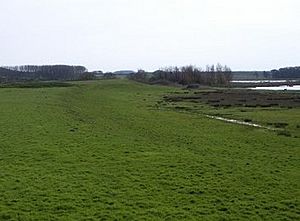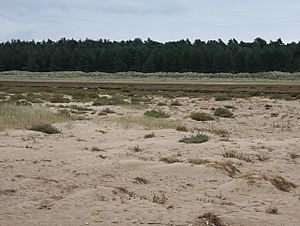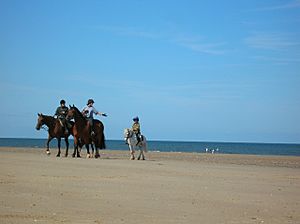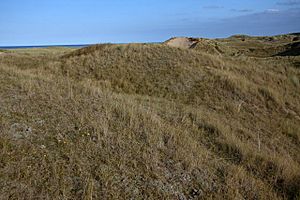Holkham National Nature Reserve facts for kids
Quick facts for kids Holkham |
|
|---|---|

Beach viewed from board-walk through the pines
|
|
| Location | Norfolk, East of England, England |
Holkham National Nature Reserve (NNR) is the biggest nature reserve in England. You can find it on the Norfolk coast, between Burnham Overy Staithe and Blakeney. Natural England helps manage this special place, working with the Holkham Estate.
The reserve covers a huge area of about 3,900 hectares (9,600 acres). It has many different natural areas, like grassy fields, woodlands, salty marshes, sandy hills, and the beach area where the tide goes in and out.
Holkham NNR is super important for birds that spend the winter here, especially pink-footed geese, wigeons, and brent geese. Many wader birds also breed here, and lots of migrating birds stop by in autumn. You can also find rare invertebrates (like insects) and plants in the sand dunes. It's one of only two places in the UK where you can find an antlion colony!
This coastal area used to be mostly salt marshes, protected by natural ridges of stones and sand. Long ago, an Iron Age fort stood here, surrounded by the wet marshland. Later, the Vikings used the waterways to reach Holkham village. Over time, people started draining the marshes to create farmland, which was finished by 1859.
The Coke family, who later became the Earls of Leicester, have owned the Holkham estate since 1609. Their home, Holkham Hall, is right across from the reserve's main entrance. In the late 1800s, the 3rd Earl planted pine trees on the dunes. These trees helped protect the new farmland from sand blown by the wind. Holkham NNR was officially created in 1967.
More than 100,000 people visit the reserve every year. This includes birdwatchers and horse riders, which helps the local economy. To protect the delicate habitats, the NNR has rules about where people can go. The dunes are also a natural barrier, helping to protect the coast from rising sea levels.
Contents
Exploring Holkham's Natural Beauty
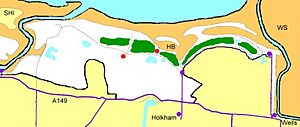
- Pasture and dunes
- Pines
- Tidal foreshore and salt marsh
- Roads and car parks
- Bird hides
- SHI: Scolt Head Island NNR
- HB: Holkham Bay
- WS: Wells salt marshes (part of Holkham NNR)
The reserve is located north of the A149 coast road. It stretches from just west of Burnham Overy Staithe to Beach Road in Wells-next-the-Sea. It also includes the tidal salt marshes that go further east towards Blakeney. Its total size of about 3,900 hectares (9,600 acres) makes it the largest NNR in England.
You can reach the reserve using footpaths from Wells and nearby villages. The Peddars Way/Norfolk Coast long-distance path goes right through the main part of the reserve. National Cycle Route 1 also loops through the heart of the NNR between Holkham and Wells.
There's a car park near Holkham village at the end of Lady Anne's Drive, which leads to two bird hides. Another parking area is at the end of Beach Road in Wells. East of the Wells Channel, the reserve is mostly salt marshes and mud flats. These areas can be tricky and even dangerous to access, though a public footpath runs along their southern edge.
Special Habitats at Holkham
The salt marshes along this coast are considered "among the best in Europe" because they have so many different plants. Holkham also has great examples of sand dunes. The pine trees planted on the dunes have helped other trees and bushes grow, making this the only large woodland area in the North Norfolk Coast special area.
The dunes are always changing because of the wind and sea. Some sand islands in Holkham Bay have formed only in the last 60 years. The flat land behind the dunes used to be a salt marsh that was drained and used for grazing until the 1940s. During World War II, it was turned into farmland.
This change lowered the water level, which wasn't good for wildlife. But Natural England has worked to raise the water levels again, bringing back many breeding and wintering birds. Managing the water helps breeding waders in summer and is drier in winter, which geese prefer. These efforts have greatly increased the number of wetland birds.
A Look Back at Holkham's Past
Norfolk has been home to people for a very long time. Both modern humans and Neanderthals lived here between 100,000 and 10,000 years ago. As the ice from the last ice age melted, the sea level rose, filling what is now the North Sea. This brought the Norfolk coastline closer to where it is today.
The coast at Holkham was originally salt marshes, protected by ridges of shingle and sand. A large Iron Age fort was built on a sandy spit in the marshes. It could only be reached along this spit and was used until about 47 AD. The Vikings later used the tidal creeks to establish Holkham village, whose name means "ship town" in Danish.
The Coke family has owned the Holkham Estate since 1609. Holkham Hall, their grand home, was built between 1734 and 1764 and is opposite the reserve's entrance. Until the 1600s, ships could sail up the tidal creeks to a harbour in Holkham village. However, local landowners started draining the marshes in 1639 to create farmland. The last part of this work was finished in 1859, turning about 800 hectares (2,000 acres) into fields.
In the late 1800s, the 3rd Earl of Leicester planted different types of pine trees on the dunes. These trees helped protect the new farmland from sand blown by strong winds. The Holkham National Nature Reserve was created in 1967. It included 1,700 hectares (4,200 acres) from the Holkham Estate and 2,200 hectares (5,400 acres) of sand and mud flats owned by the Crown Estate.
In 1986, Holkham NNR became part of the larger North Norfolk Coast special area. This whole area is now also protected by international agreements like Natura 2000, Special Protection Area (SPA), and Ramsar listings. It's also part of the Norfolk Coast Area of Outstanding Natural Beauty and a Biosphere Reserve.
Amazing Animals and Plants
Birds of Holkham

Holkham is a very important place for birds, especially in winter. As many as 50,000 pink-footed geese, 13,000 wigeons, and 7,000 brent geese spend the winter here. You might also see up to 400 white-fronted geese and a few tundra bean geese. Birds of prey like peregrine falcons, short-eared owls, and marsh harriers hunt over the fields.
On the shingle banks and foreshore, you can spot wintering flocks of shore larks, snow buntings, and twite. Waders like knots, curlews, and dunlins search for invertebrates in the mud flats.
In spring, things are a bit quieter, but you might see ring ouzels and firecrests. Breeding birds include lapwings, snipe, avocets, and redshanks in the marshes. On the beach, ringed plovers and little terns nest.
The small colony of grey herons has grown to include little egrets and, since 2010, spoonbills. In 2020, cattle egrets successfully bred here for the first time in Norfolk! The pine woods sometimes have nesting siskins or crossbills.
Holkham's location on the north coast means it can attract many migrating birds in autumn, especially with winds from the north or northeast. Common species might be joined by a wryneck, red-backed shrike, or greenish warbler in August. Later in the season, you might see goldcrests, thrushes, and finches, or even rarer birds like red-breasted flycatchers and yellow-browed warblers.
Other Wildlife and Plants
Brown hares and otters live all along the north Norfolk coast. Sadly, red squirrels disappeared from the Holkham pines by 1981. The rare natterjack toad breeds at Holkham, one of only two places along this coast. You can also find common frogs, common toads, and common lizards in the right habitats.
Butterflies like the green hairstreak, purple hairstreak, and comma are sometimes seen in the woods. Moths like the hummingbird hawk-moth and broad-bordered bee hawk-moth also fly here. In some years, you might even spot a clouded yellow or Camberwell beauty.
In the dunes, you can find grayling, small heath, and common blue butterflies. Holkham is also home to a large antlion colony, making it one of only two places in the UK for this insect. Dragonflies like the migrant hawker and ruddy darter are also present.
On the exposed parts of the coast, the strong tides mean there isn't much plant life, maybe just algae or eelgrass. But in more protected areas, important salt marshes grow with several unusual plant species. The salt marsh starts with plants like glassworts and annual seablite. As the marsh develops, you'll see sea aster, then mostly sea lavender, with sea purslane in the creeks.
Drier parts of the upper salt marsh have plants like scrubby sea-blite and matted sea lavender, which are rare in the UK outside of Norfolk. Grasses like sea couch grass and sea poa grass are important in the driest marsh areas. On the coastal dunes, plants like marram grass and sand couch-grass help to hold the sand in place.
Other special plants of this dry habitat include sea holly and sand sedge. Petalwort, a rare moss-like plant, grows on damper dunes. On the more stable dunes, you can find bird's-foot trefoil, pyramidal orchids, and bee orchids. The narrow belt of pine trees also shelters rare plants like creeping lady's tresses.
Fun and Protecting the Reserve
Holkham National Nature Reserve is a popular spot! A survey in 2005 found that 39% of visitors came mainly for birdwatching. Millions of day visitors and those staying overnight spend a lot of money in the area, supporting many jobs. Holkham NNR is one of three sites along this coast that get over 100,000 visitors each year.
However, many visitors can sometimes cause problems. Wildlife can be disturbed, especially birds that nest in open areas like ringed plovers and little terns. Plants can also be trampled, which is a big issue in delicate places like dunes.
To protect the little tern colony, which holds 7% of Britain's population, parts of the beach are roped off during breeding season. Signs explain why people need to stay out of these areas. Walking too much on the dune plants can damage them, leading to sand erosion. So, boardwalks and steps are built to help visitors reach the beach without harming the dunes. Horse riders are asked to stay on the beach and off the dunes.
As the climate gets warmer, more tourists might visit the coast. However, this could be balanced by people choosing activities that have less impact on nature, like swimming.
The Norfolk Coast Partnership, a group of conservation organizations, divides the coast into different zones for tourism. Holkham Dunes is in a "red zone," meaning it's a sensitive habitat already feeling pressure from visitors. So, no new developments or parking improvements are recommended there. The rest of the NNR is in an "orange zone," for places with fragile habitats but less tourism pressure.
Protecting Our Coastline
The Norfolk coast is made of Cretaceous chalk underneath, but it's covered by soft glacial material along the Holkham area. Unlike cliffs that erode quickly, this coastline has been more stable. However, climate change is a threat, with sea levels rising about 1-2 mm per year for the last century. This increases the risk of flooding and coastal erosion.
About half of the salt marshes behind Scolt Head Island have been turned into grazing marshes over the last 300 years. These marshes are important for wildlife but are very fragile. Holkham is low-lying and can flood in bad weather. But it's protected by a sand spit that formed in the 1990s and by the dunes along the coast, which are becoming more stable with plants growing on them.
The Environment Agency plans to rely on the natural protection of the dunes until 2105. They will only step in if work is needed to keep the dunes effective against a possible sea level rise of 1.1 meters (3 feet) by that time. The shingle (small stones) that makes up Scolt Head Island is slowly moving west and south. This might affect how sand moves and cause some erosion of the dunes and beaches at Holkham. However, it shouldn't destroy their ability to protect the coast unless the island reattaches to the mainland far in the future.
Images for kids



